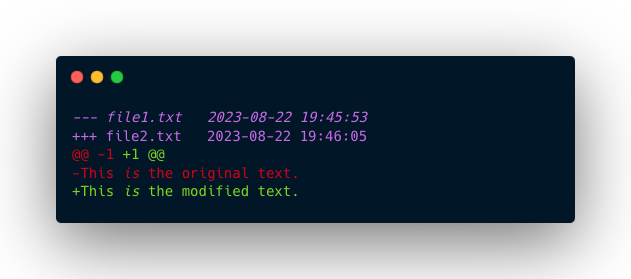Hey, Everyone!
I’m back with a blog post, focussing on Patch Diff Analysis part.
What is Patch Diff ?

“patch” or “diff” , is a utility used in software development and version control systems to compare two sets of files and identify the differences between them. The term “diff” is short for “difference.”
Syntax for Diff
diff <option> <original_file> <modified_file> > <patch_file>
Most commonly used diff options

More options can be found here Options to diff
To generate a diff use the diff command in Unix/Linux, you typically use the following format:
diff -u <original_file> <modified_file> > <patch_file>
Here’s what each part of the command means:
diff: This is the command itself, which is used to compare files and generate the patch diff.u: This option tells diff to use the unified diff format, which is the most commonly used and human-readable format for patches.<original_file>: This is the path to the original file, the one you want to compare against.<modified_file>: This is the path to the modified file, the one you have made changes to.>: This is the output redirection symbol that saves the generated patch diff to a file.<patch_file>: This is the name of the file where the patch diff will be saved.
Let’s illustrate this with an example. Suppose we have two text files, file1.txt and file2.txt, and we want to generate a patch diff (see what codes are changed) between them:
file1.txt
This is the original text.
file2.txt
This is the modified text.
We can use the diff command to generate the patch diff:
diff -u file1.txt file2.txt > my_patch.diff
This command will compare file1.txt and file2.txt, and the output will be redirected to a file named my_patch.diff.
The content of my_patch.diff will look like this:
--- file1.txt 2023-07-23 10:00:00.000000000 -0400
+++ file2.txt 2023-07-23 10:00:00.000000000 -0400
@@ -1 +1 @@
-This is the original text.
+This is the modified text.
- — and +++ indicate the file names and timestamps.
- @@ provides information about the line numbers and context of the changes.
- - and + represent the lines removed and added, respectively.
In this example, the diff shows that the original line was removed, and the modified line was added.
Patch Diff to see What is Changed & What was Vulnerable ?
Let’s consider a patch diff analysis with a focus on a security-related change in an open-source project.
In this example, we’ll analyze a security fix applied to a web application project.
- Clone the Repository.
git clone <repository_url>
cd web-app-project
-
Identify the Versions: Suppose we want to analyze the security fix applied between commit v1.0 (old version) and commit v1.1 (new version).
-
Generate the Patch.
git diff v1.0 v1.1 > security_patch.diff
- Read and Analyze the Patch: Open the security_patch.diff file using a text editor. Let’s assume you find the following change related to authentication:
-// Insecure authentication method
-function authenticateUser(username, password) {
- // No hashing, plain password comparison
- return users[username] === password;
-}
+
+// Secure authentication method
+function authenticateUser(username, password) {
+ // Hash the password before comparison
+ const hashedPassword = hashPassword(password);
+ return users[username] === hashedPassword;
+}
+
+function hashPassword(password) {
+ // Implement secure password hashing algorithm
+ // ...
+}
-
In this example, the project has replaced the Insecure Password Comparison method with a more secure approach that involves hashing passwords before comparing them.
-
This change aims to prevent plain text password storage and improve authentication security.
Reference:
- An introduction to diffs and patches
- Patch Diffing
- How to use diff and patch
- Diff and Patch : A Guide

Thanks a lot for reading !!!.